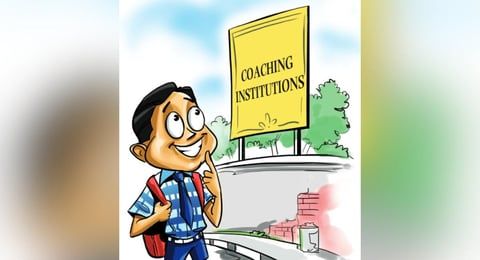Author: Upanshi Upadhyay
FIMT, (GGSIPU)
To the Point
In India’s highly competitive educational environment, coaching centers are crucial in shaping the academic futures of many students. However, recent tragic incidents, such as the devastating flooding at Rau’s IAS Academy in Delhi’s Old Rajinder Nagar, have starkly highlighted the severe deficiencies in the regulatory oversight of these institutions. The existing regulatory framework is inadequate for addressing the specific safety and operational needs of coaching centers. This article delves into the current regulatory structure, identifies the gaps exposed by recent tragedies, and proposes essential reforms to improve student safety and institutional accountability.
Use of Legal Jargon
The regulatory oversight for coaching centers in India is governed by a mix of generic business regulations rather than education-specific laws. Key statutes include the Registration Act, 1908, which mandates the registration of coaching centers as business entities, and the Shops and Establishment Act, which regulates operational aspects. Additionally, the Consumer Protection Act, 2019, provides a mechanism for redressal of grievances but falls short of proactive safety and infrastructure requirements. Current health and safety standards are derived from broader public safety regulations, but these do not address the unique context of coaching centers. Infrastructure regulations are determined by local building codes and zoning laws, which often lack specific provisions for educational institutions, leading to significant regulatory gaps.
The Proof
Recent tragedies have laid bare the inadequacies of the current regulatory framework. The catastrophic flooding at Rau’s IAS Academy, which tragically led to the deaths of three students, underscored several critical issues:
Inadequate Infrastructure Safety: The use of a basement as a library in a flood-prone area exposed severe lapses in infrastructure safety regulations. The absence of specialized safety assessments and certifications for educational facilities means that coaching centers can operate without meeting rigorous safety standards, which can endanger students’ lives.
Delayed Emergency Response: The slow and ineffective emergency response during the flooding incident highlighted a significant gap in emergency preparedness. The lack of comprehensive emergency plans and regular drills for staff members impeded timely rescue efforts, demonstrating a critical need for improved emergency response protocols.
Regulatory Oversight Deficiencies: The incident revealed significant shortcomings in the enforcement of safety standards for coaching centers. The existing oversight mechanisms are inadequate for ensuring compliance with safety and infrastructure regulations, pointing to the necessity of a dedicated regulatory body to oversee these aspects effectively.
Abstract
The regulatory framework for coaching centers in India is fragmented and insufficient for addressing the specific safety and operational needs of these institutions. The recent tragedy at Rau’s IAS Academy, where three students lost their lives due to flooding, has exposed severe deficiencies in the existing regulatory framework. This article examines these gaps and advocates for a comprehensive reform strategy. The proposed reforms aim to introduce specific regulations for coaching centers, mandate safety certifications, enhance emergency preparedness, strengthen enforcement mechanisms, and promote transparency and accountability. By addressing these issues, the reforms seek to create a safer educational environment and prevent future tragedies, ensuring that coaching centers operate with the highest standards of safety and integrity.
Case Laws
While specific case laws related to coaching centers are sparse, several legal precedents highlight the broader issues of safety and regulatory compliance:
State of Gujarat v. M. A. M., 1997 (3) SCC 428: This case emphasized the duty of institutions to ensure the safety of their premises, underscoring the need for strict adherence to safety regulations.
Recommendations for Reform
To address the regulatory deficiencies highlighted by recent tragedies, the following reforms are proposed:
Introduction of Specific Regulations: Establish targeted regulations specifically for coaching centers, addressing infrastructure, safety, and operational standards. A specialized regulatory body should be created to oversee these aspects and conduct regular inspections.
Mandatory Safety Certifications: Require coaching centers to obtain safety certifications from relevant authorities. These certifications should encompass structural integrity, fire safety, and emergency preparedness, ensuring compliance with high safety standards.
Enhanced Emergency Preparedness: Mandate comprehensive emergency response plans for coaching centers, including regular training and drills for staff. This will ensure effective crisis management and enhance student safety.
Strengthening Enforcement Mechanisms: Empower local and state authorities to enforce compliance with safety regulations. This includes imposing penalties for non-compliance and ensuring prompt corrective actions.
Promoting Transparency and Accountability: Increase transparency in the operations of coaching centers through regular reporting and public awareness initiatives. This will enable students and parents to make informed decisions and advocate for higher safety standards.
Conclusion
The tragedy at Rau’s IAS Academy serves as a critical wake-up call for the need to overhaul the regulatory framework governing coaching centers in India. The current regulations, while providing a foundational structure, fail to address the specific needs and risks associated with educational institutions. To prevent future tragedies, it is imperative to implement a comprehensive regulatory framework that emphasizes safety, emergency preparedness, and institutional accountability.
The proposed reforms aim to establish a robust regulatory environment by introducing specific regulations, mandating safety certifications, enhancing emergency preparedness, strengthening enforcement mechanisms, and promoting transparency. These changes are crucial to ensuring that coaching centers operate in a manner that prioritizes student safety and well-being, ultimately creating a secure educational environment for future generations.
The collective responsibility of regulators, educational institutions, and the community is essential in driving these reforms. By addressing the current regulatory gaps and implementing the recommended changes, we can safeguard the pursuit of educational excellence from preventable risks and tragedies.
FAQS
Q1: What are the current regulations governing coaching centers in India?
A1: Coaching centers in India are primarily governed by the Registration Act, 1908, and the Shops and Establishment Act. These laws ensure business legitimacy but do not address the specific needs of educational institutions. General health and safety standards, as well as local building codes, also apply.
Q2: What recent incident highlighted the deficiencies in the regulatory framework for coaching centers?
A2: The tragic flooding incident at Rau’s IAS Academy in Delhi, which resulted in the deaths of three students, exposed critical deficiencies in the regulatory framework, including inadequate infrastructure safety and delayed emergency response.
Q3: What are the proposed reforms to improve safety in coaching centers?
A3: Proposed reforms include the introduction of specific regulations for coaching centers, mandatory safety certifications, enhanced emergency preparedness, strengthened enforcement mechanisms, and increased transparency and accountability.
Q4: Why is a specialized regulatory body needed for coaching centers?
A4: A specialized regulatory body would provide focused oversight, ensuring that coaching centers adhere to specific safety, infrastructure, and operational standards tailored to their unique needs, thereby enhancing overall student safety.
Q5: How can transparency and accountability be promoted in coaching centers?
A5: Transparency and accountability can be promoted through regular reporting, public awareness initiatives, and fostering an environment where students and parents can make informed decisions and advocate for higher safety standards.






